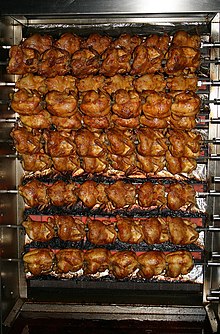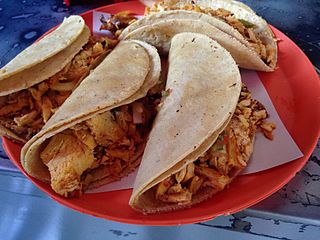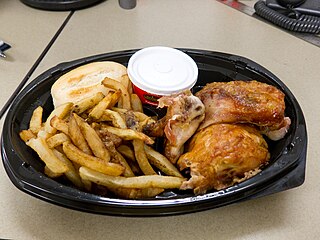
Rotisserie chicken is a chicken dish that is cooked on a rotisserie by using direct heat in which the chicken is placed next to the heat source.
Electric- or gas-powered heating elements may be used by using adjustable infrared heat. These types of rotisseries have proven quite functional for cooking rotisserie-style chicken. Leftover rotisserie chicken may be used in a variety of dishes such as soup, chicken salad, and sandwiches.
Grocery loss leader
Rotisserie chickens are often sold at a lower price than raw whole chickens in grocery stores. Two explanations are often given to justify this phenomenon. First, some grocery stores may use rotisserie chickens as loss leaders to bring shoppers into the store. The logic behind this theory is that if customers come to a store for its rotisserie chickens, they will buy other products while they are there, as well, particularly higher-margin side dishes and alcoholic beverages to accompany the chicken. Second, rotisserie chickens are often made with poultry that is about to reach its "best by" date and would otherwise have to be destroyed unsold. By cooking and selling the chickens, the grocery stores are able to recoup some of their expenditures.
By region
Australia
The two major supermarkets, Coles and Woolworths, both sell chickens cooked in large ovens. A common variation on the local fish and chip shop is one that also sells charcoal chicken, rotated and cooked above charcoal.
Canada
Rotisserie chicken has been a popular food in Canada since the 1950s, and is a staple of Canadian pop culture.
Two Canadian casual dining restaurant chains, Swiss Chalet and St-Hubert, dominate the market for chicken, though the dish is also the central item for other Canadian chains, popular international chains such as Nandos, or individual restaurants. Swiss Chalet owns a cable channel that exclusively airs content related to rotisserie chicken, "twenty-four hours a day, seven days a week." It typically airs chickens rotating on a rotisserie. Occasionally, a dancing man appears wearing a costume that looks "like a container of Swiss Chalet's dipping sauce."
Most Canadian supermarket chains (including Costco) sell rotisserie chicken as a loss leader, similar to supermarkets in the United States.
France
Napoleon Bonaparte was a frequent consumer of rotisserie chickens.
Mexico
In Mexico, rotisserie chicken is called "pollo asado" or "pollo rostizado" (which literally mean "grilled chicken" and "roasted chicken" respectively). Rotisserie chicken is often sold at restaurants specializing in rotisserie chicken and is eaten with tortillas, salsa, and sides of arroz rojo and refried beans; it can also be found at supermarkets or warehouse clubs such as Costco or Sam's Club.
Peru
Pollo a la brasa (literally "roasted chicken") is a national dish, with Peruvians consuming it an average of three times per month and with rotisserie chicken restaurants accounting for 40% of the fast food industry in the country. Peruvian-style rotisserie chicken has been growing in popularity worldwide, especially in the United States, where a large number of such restaurants have opened in the past two decades.
United States
In the United States, ready-to-eat rotisserie chickens were available in supermarkets and some butcher shops during much of the twentieth century. However, they did not become a widely available option for consumers until the early 1990s, when Boston Market helped popularize the selling of packaged rotisserie chickens.
Rotisserie chickens are now highly popular. In 2010, 600 million rotisserie-cooked chickens were purchased by consumers "in U.S. supermarkets, club stores and similar retail outlets." In 2018, over 900 million rotisserie chickens were sold by foodservice outlets and retail stores.
In the U.S., chickens used for rotisserie cooking may be injected with brine to retain moisture. Additional ingredients may be used to add flavor and to brown the chicken, such as oleoresin, yeast extract, sodium tripolyphosphate, and natural flavorings.
Most American large supermarkets (including Costco and Sam's Club) sell rotisserie chicken as a loss leader.
Costco and rotisserie chickens
Costco is one of the largest producers and vendors of rotisserie chickens in the United States, with one commentator describing it as "the undisputed king of rotisserie chickens." In 2017, Costco sold approximately 87 million rotisserie chickens in the United States. That number rose to 106 million chickens in 2021. Costco's CFO, Richard Galanti, has repeatedly rebuffed suggestions that Costco might eventually increase the cost of its chickens above $4.99, which has been the price of a Costco rotisserie chicken since 2009.
In 2017, Costco broke ground on a new 414-acre facility in Fremont, Nebraska that would include a hatchery, feed mill, and processing plant. The facility – which is expected to produce around 100 million chickens per year, or roughly 40 percent of Costco's needs – has been reported as costing between $275 million and $400 million. The plant opened in 2019, and is operating as Lincoln Premium Poultry.
Internet celebrities
In 2022, Alexander Tominsky, a waiter in Philadelphia, became a local celebrity after eating a rotisserie chicken every day for 40 consecutive days.
Also in 2022, Spanish-speaking TikTok user @donpollo2982 gained notoriety in June after sharing videos of him eating food in his car, usually rotisserie chicken, while often being interrupted by sounds emitted from his Android smartphone.
Gallery
-
 Chickens being roasted on a spit. Romance of Alexander, Bruges, 1338-44 (The Bodleian Library, Oxford, MS 264 fol 170v)
Chickens being roasted on a spit. Romance of Alexander, Bruges, 1338-44 (The Bodleian Library, Oxford, MS 264 fol 170v)
-
 Rotisserie chicken prepped for cooking on a barbecue grill
Rotisserie chicken prepped for cooking on a barbecue grill
-
Rotisserie chicken (pollo rostizado) cooking at a take-out shop in the Obrera neighborhood of Mexico City
-
 Roast chicken tacos, colonia Condesa, Mexico City
Roast chicken tacos, colonia Condesa, Mexico City
-
A Costco rotisserie chicken
-
A packaged rotisserie chicken
-
 Rotisserie chicken being cooked at a restaurant in California
Rotisserie chicken being cooked at a restaurant in California
-
 Swiss Chalet 1/2 Chicken dinner ordered as take-out
Swiss Chalet 1/2 Chicken dinner ordered as take-out
See also
- Barbecue chicken
- Beer can chicken
- Chicken restaurant
- Huli-huli chicken
- List of chicken dishes
- List of spit-roasted foods
- Siu mei
References
Citations
- Raichlen 2001, p. 211
- Krasner, Deborah (2007). The new outdoor kitchen: cooking up a kitchen for the way you live and play. Taunton Press. pp. 61-62. ISBN 1561588040
- Gisslen, Wayne; (et al.) (2006) Professional Cooking, for Canadian Chefs. John Wiley & Sons. 9. 47. ISBN 0471663778
- ^ Benwick, Bonnie S. (October 30, 2012). "The bird that goes around, stays around". The Washington Post. Retrieved January 2, 2019.
- ^ Galarza, Daniela (January 5, 2018). "Why Costco Will Never Raise the Price of Rotisserie Chicken". Eater. Archived from the original on January 2, 2019.
- Tuttle, Brad (January 4, 2018). "Here's the Real Reason Costco Will Never Stop Selling $4.99 Rotisserie Chicken". Money.com. Archived from the original on May 11, 2021.
- Holden, Ronald (January 4, 2018). "Brawk! Rotisserie Chickens Get Off The Spit". Forbes. Archived from the original on January 5, 2018.
Even if they're used as loss leaders, at, say, $5 apiece, that's still a decent chunk of change. But the assumption is that many shoppers will also pick up a salad, a side dish, and maybe a bottle of wine.
- ^ Vasko, Cat (March 4, 2014). "Grocery Store Economics: Why Are Rotisserie Chickens So Cheap?". KCET. Archived from the original on January 1, 2019.
- ^ Dean, Sam (May 17, 2012). "The 24-Hour Chicken Channel". Huffington Post. Retrieved 27 March 2015.
- Nerman, Danielle (2022-04-19). "Why prepared rotisserie chickens are cheaper than ones you cook yourself". Canadian Broadcasting Corporation. Archived from the original on 2023-04-07.
- Blakemore, Erin (June 19, 2015). "Napoleon Had a Thing for Rotisserie Chicken". Smithsonian. Archived from the original on February 5, 2017.
- "The history and preparation of this very Peruvian dish, 'pollo a la brasa' (rotisserie chicken)". Peru.info. 23 June 2020. Retrieved 1 March 2022.
- Galarza, Daniela (January 17, 2018). "Why Whole Foods Is Banking on Rotisserie Chicken". Eater. Archived from the original on January 2, 2019.
The consumer demand for rotisserie chicken isn't exactly new. Chains like A&P "always had chickens rotating on rotisseries in large commercial ovens with big glass windows," writes B. Baker, an Eater reader who grew up in the 1960s and remembers that "customers would come in expressly to pick up a chicken for dinner; there were no Boston Markets, Costcos, or even (in our area) KFCs to purchase a prepared bird." But according to the Journal, it wasn't until the '90s that national chains like Costco and Whole Foods started buying birds specifically to put them on a spit and sell them for less than fresh broilers, turning rotisserie chicken into a lucrative loss leader.
- ^ Crockett, Zachary (January 11, 2018). "The legacy of the rotisserie chicken: grocery stores' golden goose". The Hustle. Archived from the original on January 2, 2019.
- Gasparro, Annie (January 4, 2018). "Rotisserie Chickens: The '90s Gift to Supermarkets That Keeps on Giving". The Wall Street Journal. Retrieved January 2, 2019.
- Klein, Karin (August 15, 2016). "Are Rotisserie Chickens a Bargain?". Priceonomics. Archived from the original on January 2, 2019.
- Benwick, Bonnie S. (October 30, 2012). "The bird that goes around, stays around". The Washington Post. Retrieved 27 March 2015.
- Glazer, Fern (October 5, 2018). "Rotisserie chicken catches fire". Nation's Restaurant News. Archived from the original on January 2, 2019.
- ^ Meisenzahl, Mary (June 18, 2022). "See inside Costco's controversial Nebraska chicken plant that produces millions of $4.99 rotisserie chickens each year". Insider. Retrieved July 20, 2023.
- González, Ángel (May 28, 2015). "Costco philosophical about keeping chicken prices low". The Seattle Times. Archived from the original on January 2, 2019.
- ^ Romano, Benjamin (September 21, 2018). "Costco takes rotisserie chicken supply chain under its wing". The Seattle Times. Archived from the original on January 2, 2019.
- ^ Taylor, Kate (September 21, 2018). "Costco has a $275 million plan to make sure its rotisserie chicken never costs more than $5". Business Insider. Archived from the original on January 2, 2019.
- Gerlock, Grant (October 22, 2018). "Costco Builds Nebraska Supply Chain For Its $5 Rotisserie Chickens". NPR. Archived from the original on January 2, 2019.
- Farrell, James (August 27, 2018). "Raising a chicken plant: A look at the players involved in constructing the incoming Costco and LPP plant". Fremont Tribune. Archived from the original on January 2, 2019.
- Medina, Eduardo (7 November 2022). "40 Chickens in 40 Days: How a Philadelphia Man Cheered His City". The New York Times. Retrieved 6 December 2022.
- "How rotisserie 'chicken man' became viral sensation". BBC News. Retrieved 6 December 2022.
- Desouza, Danielle (6 November 2022). "Restaurant worker to complete 40-day challenge eating only rotisserie chicken". The Independent. Retrieved 6 December 2022.
- Staples, Louis (8 November 2022). "An Interview With the Guy Who Ate a Chicken Every Day for 40 Days". Vice.
- Yomary, Tatayana (30 November 2022). "Who Is Don Pollo on TikTok? Details on the "King of Ohio"". Distractify. Retrieved 2 January 2023.
Sources
- Adler, Karen; Fertig, Judith M. (2005).The Barbecue Queens' Big Book of Barbecue. Harvard Common Press. p. 217. ISBN 1558322973
- Raichlen, Steven (2001). How to Grill: The Complete Illustrated Book of Barbecue Techniques, a Barbecue Bible! Cookbook. Workman Publishing. ISBN 0761120149
Further reading
- Baird, M. (2009). 101 Things to do with Rotisserie Chicken. Gibbs Smith. ISBN 978-1-4236-0764-9.